马上注册,结交更多好友,享用更多功能,让你轻松玩转社区。
您需要 登录 才可以下载或查看,没有账号?立即注册

×
《Applied Shape Optimization for Fluids》第二版
流体的应用形状优化
作者:Bijan Mohammadi
University Montpellier II
Olivier Pironneau
University Paris VI
出版社:Oxford
出版时间:2010年
《Applied Shape Optimization for Fluids》第二版
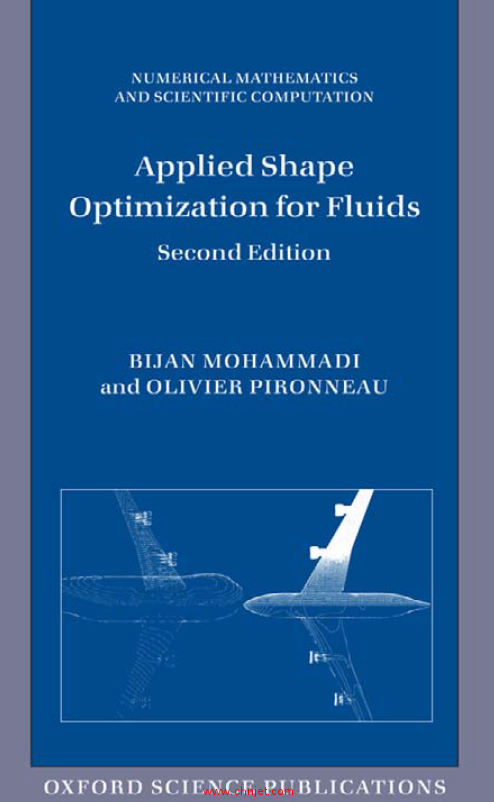
《Applied Shape Optimization for Fluids》第二版
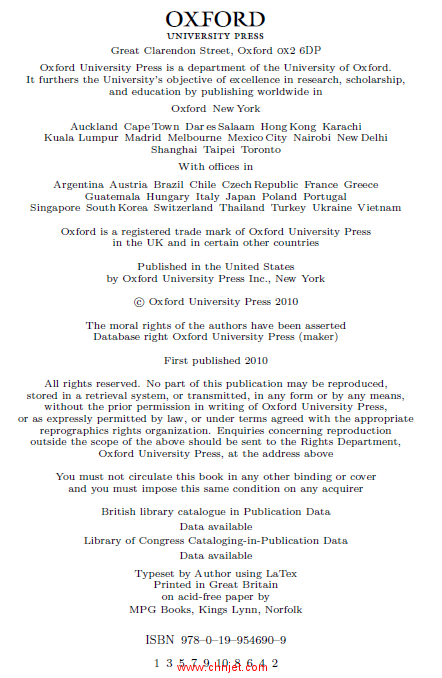
《Applied Shape Optimization for Fluids》第二版
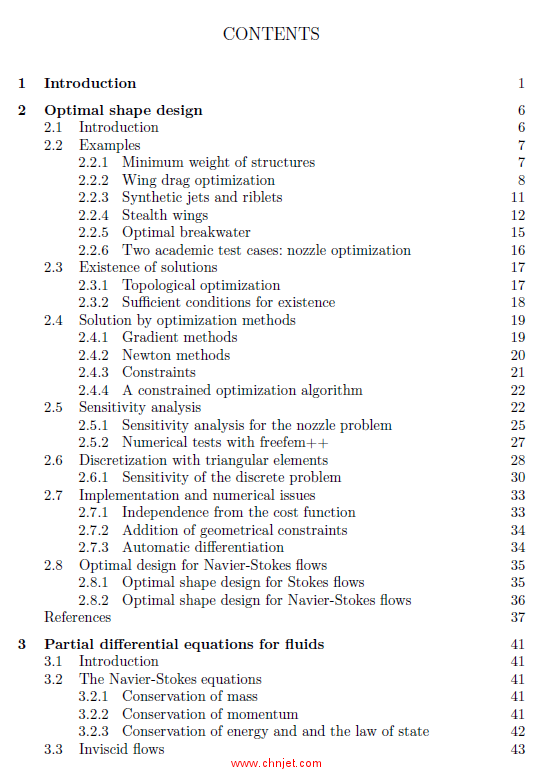
《Applied Shape Optimization for Fluids》第二版
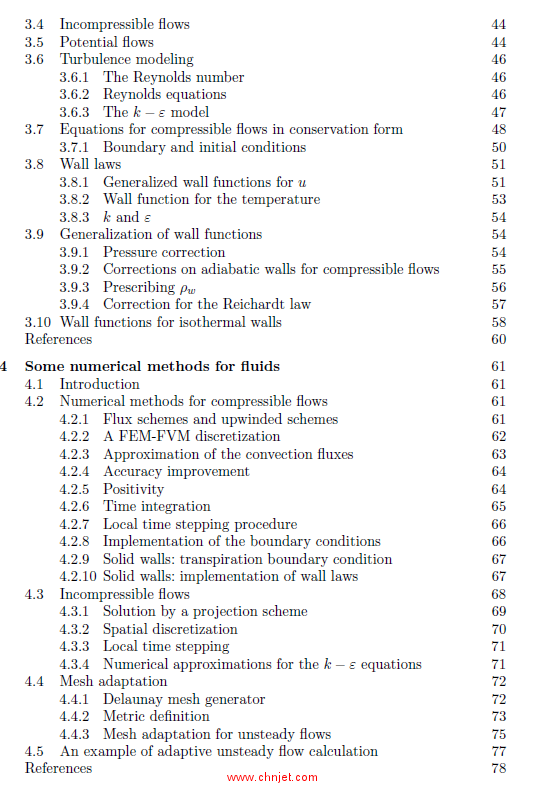
《Applied Shape Optimization for Fluids》第二版
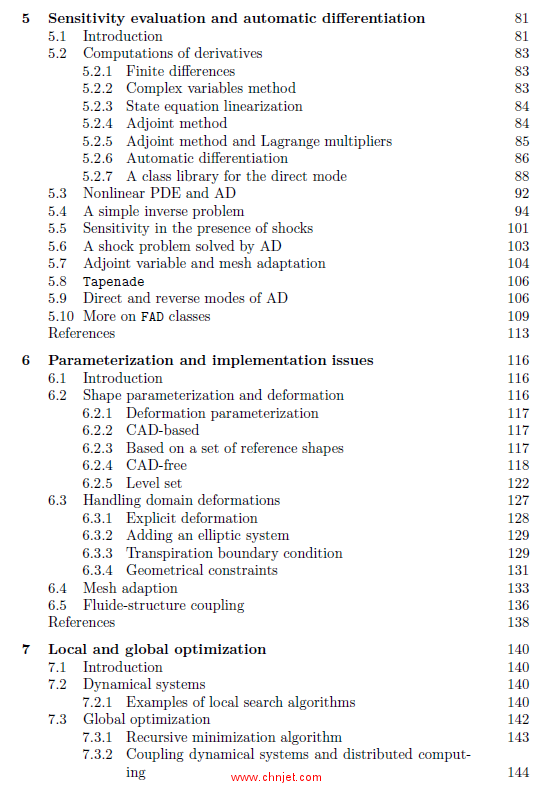
CONTENTS
1 Introduction 1
2 Optimal shape design 6
2.1 Introduction 6
2.2 Examples 7
2.2.1 Minimum weight of structures 7
2.2.2 Wing drag optimization 8
2.2.3 Synthetic jets and riblets 11
2.2.4 Stealth wings 12
2.2.5 Optimal breakwater 15
2.2.6 Two academic test cases: nozzle optimization 16
2.3 Existence of solutions 17
2.3.1 Topological optimization 17
2.3.2 Sufficient conditions for existence 18
2.4 Solution by optimization methods 19
2.4.1 Gradient methods 19
2.4.2 Newton methods 20
2.4.3 Constraints 21
2.4.4 A constrained optimization algorithm 22
2.5 Sensitivity analysis 22
2.5.1 Sensitivity analysis for the nozzle problem 25
2.5.2 Numerical tests with freefem++ 27
2.6 Discretization with triangular elements 28
2.6.1 Sensitivity of the discrete problem 30
2.7 Implementation and numerical issues 33
2.7.1 Independence from the cost function 33
2.7.2 Addition of geometrical constraints 34
2.7.3 Automatic differentiation 34
2.8 Optimal design for Navier-Stokes flows 35
2.8.1 Optimal shape design for Stokes flows 35
2.8.2 Optimal shape design for Navier-Stokes flows 36
References 37
3 Partial differential equations for fluids 41
3.1 Introduction 41
3.2 The Navier-Stokes equations 41
3.2.1 Conservation of mass 41
3.2.2 Conservation of momentum 41
3.2.3 Conservation of energy and and the law of state 42
3.3 Inviscid flows 43
x Contents
3.4 Incompressible flows 44
3.5 Potential flows 44
3.6 Turbulence modeling 46
3.6.1 The Reynolds number 46
3.6.2 Reynolds equations 46
3.6.3 The k − ε model 47
3.7 Equations for compressible flows in conservation form 48
3.7.1 Boundary and initial conditions 50
3.8 Wall laws 51
3.8.1 Generalized wall functions for u 51
3.8.2 Wall function for the temperature 53
3.8.3 k and ε 54
3.9 Generalization of wall functions 54
3.9.1 Pressure correction 54
3.9.2 Corrections on adiabatic walls for compressible flows 55
3.9.3 Prescribing ρw 56
3.9.4 Correction for the Reichardt law 57
3.10 Wall functions for isothermal walls 58
References 60
4 Some numerical methods for fluids 61
4.1 Introduction 61
4.2 Numerical methods for compressible flows 61
4.2.1 Flux schemes and upwinded schemes 61
4.2.2 A FEM-FVM discretization 62
4.2.3 Approximation of the convection fluxes 63
4.2.4 Accuracy improvement 64
4.2.5 Positivity 64
4.2.6 Time integration 65
4.2.7 Local time stepping procedure 66
4.2.8 Implementation of the boundary conditions 66
4.2.9 Solid walls: transpiration boundary condition 67
4.2.10 Solid walls: implementation of wall laws 67
4.3 Incompressible flows 68
4.3.1 Solution by a projection scheme 69
4.3.2 Spatial discretization 70
4.3.3 Local time stepping 71
4.3.4 Numerical approximations for the k − ε equations 71
4.4 Mesh adaptation 72
4.4.1 Delaunay mesh generator 72
4.4.2 Metric definition 73
4.4.3 Mesh adaptation for unsteady flows 75
4.5 An example of adaptive unsteady flow calculation 77
References 78
Contents xi
5 Sensitivity evaluation and automatic differentiation 81
5.1 Introduction 81
5.2 Computations of derivatives 83
5.2.1 Finite differences 83
5.2.2 Complex variables method 83
5.2.3 State equation linearization 84
5.2.4 Adjoint method 84
5.2.5 Adjoint method and Lagrange multipliers 85
5.2.6 Automatic differentiation 86
5.2.7 A class library for the direct mode 88
5.3 Nonlinear PDE and AD 92
5.4 A simple inverse problem 94
5.5 Sensitivity in the presence of shocks 101
5.6 A shock problem solved by AD 103
5.7 Adjoint variable and mesh adaptation 104
5.8 Tapenade 106
5.9 Direct and reverse modes of AD 106
5.10 More on FAD classes 109
References 113
6 Parameterization and implementation issues 116
6.1 Introduction 116
6.2 Shape parameterization and deformation 116
6.2.1 Deformation parameterization 117
6.2.2 CAD-based 117
6.2.3 Based on a set of reference shapes 117
6.2.4 CAD-free 118
6.2.5 Level set 122
6.3 Handling domain deformations 127
6.3.1 Explicit deformation 128
6.3.2 Adding an elliptic system 129
6.3.3 Transpiration boundary condition 129
6.3.4 Geometrical constraints 131
6.4 Mesh adaption 133
6.5 Fluide-structure coupling 136
References 138
7 Local and global optimization 140
7.1 Introduction 140
7.2 Dynamical systems 140
7.2.1 Examples of local search algorithms 140
7.3 Global optimization 142
7.3.1 Recursive minimization algorithm 143
7.3.2 Coupling dynamical systems and distributed computing
144
xii Contents
7.4 Multi-objective optimization 145
7.4.1 Data mining for multi-objective optimization 148
7.5 Link with genetic algorithms 150
7.6 Reduced-order modeling and learning 153
7.6.1 Data interpolation 154
7.7 Optimal transport and shape optimization 158
References 161
8 Incomplete sensitivities 164
8.1 Introduction 164
8.2 Efficiency with AD 165
8.2.1 Limitations when using AD 165
8.2.2 Storage strategies 166
8.2.3 Key points when using AD 167
8.3 Incomplete sensitivity 168
8.3.1 Equivalent boundary condition 168
8.3.2 Examples with linear state equations 169
8.3.3 Geometric pressure estimation 171
8.3.4 Wall functions 172
8.3.5 Multi-level construction 172
8.3.6 Reduced order models and incomplete sensitivities 173
8.3.7 Redefinition of cost functions 174
8.3.8 Multi-criteria problems 175
8.3.9 Incomplete sensitivities and the Hessian 175
8.4 Time-dependent flows 176
8.4.1 Model problem 178
8.4.2 Data mining and adjoint calculation 181
References 183
9 Consistent approximations and approximate gradients 184
9.1 Introduction 184
9.2 Generalities 184
9.3 Consistent approximations 186
9.3.1 Consistent approximation 187
9.3.2 Algorithm: conceptual 187
9.4 Application to a control problem 188
9.4.1 Algorithm: control with mesh refinement 189
9.4.2 Verification of the hypothesis 189
9.4.3 Numerical example 190
9.5 Application to optimal shape design 190
9.5.1 Problem statement 191
9.5.2 Discretization 192
9.5.3 Optimality conditions: the continuous case 192
9.5.4 Optimality conditions: the discrete case 193
9.5.5 Definition of θh 194
Contents xiii
9.5.6 Implementation trick 195
9.5.7 Algorithm: OSD with mesh refinement 195
9.5.8 Orientation 196
9.5.9 Numerical example 196
9.5.10 A nozzle optimization 197
9.5.11 Theorem 199
9.5.12 Numerical results 200
9.5.13 Drag reduction for an airfoil with mesh adaptation 200
9.6 Approximate gradients 203
9.6.1 A control problem with domain decomposition 204
9.6.2 Algorithm 205
9.6.3 Numerical results 207
9.7 Conclusion 209
9.8 Hypotheses in Theorem 9.3.2.1 209
9.8.1 Inclusion 209
9.8.2 Continuity 209
9.8.3 Consistency 209
9.8.4 Continuity of θ 209
9.8.5 Continuity of θh(αh) 210
9.8.6 Convergence 210
References 210
10 Numerical results on shape optimization 212
10.1 Introduction 212
10.2 External flows around airfoils 213
10.3 Four-element airfoil optimization 213
10.4 Sonic boom reduction 215
10.5 Turbomachines 217
10.5.1 Axial blades 219
10.5.2 Radial blades 222
10.6 Business jet: impact of state evaluations 225
References 225
11 Control of unsteady flows 227
11.1 Introduction 227
11.2 A model problem for passive noise reduction 228
11.3 Control of aerodynamic instabilities around rigid bodies 229
11.4 Control in multi-disciplinary context 229
11.4.1 A model problem 230
11.4.2 Coupling strategies 236
11.4.3 Low-complexity structure models 237
11.5 Stability, robustness, and unsteadiness 241
11.6 Control of aeroelastic instabilities 244
References 245
xiv Contents
12 From airplane design to microfluidics 246
12.1 Introduction 246
12.2 Governing equations for microfluids 247
12.3 Stacking 247
12.4 Control of the extraction of infinitesimal quantities 249
12.5 Design of microfluidic channels 249
12.5.1 Reduced models for the flow 255
12.6 Microfluidic mixing device for protein folding 255
12.7 Flow equations for microfluids 259
12.7.1 Coupling algorithm 260
References 261
13 Topological optimization for fluids 263
13.1 Introduction 263
13.2 Dirichlet conditions on a shrinking hole 264
13.2.1 An example in dimension 2 264
13.3 Solution by penalty 265
13.3.1 A semi-analytical example 267
13.4 Topological derivatives for fluids 268
13.4.1 Application 268
13.5 Perspective 270
References 270
14 Conclusions and prospectives 272
Index 275
专业书籍
下载地址:(回复后可见)
| ![]()